fuel pressure TOYOTA GR SUPRA 2022 Owners Manual
[x] Cancel search | Manufacturer: TOYOTA, Model Year: 2022, Model line: GR SUPRA, Model: TOYOTA GR SUPRA 2022Pages: 356, PDF Size: 39.14 MB
Page 30 of 356

302-1. QUICK REFERENCE
1Press the rear edge of the
fuel filler flap to open it.
2 Turn the fuel cap counter-
clockwise.
3 Place the fuel cap in the
bracket attached to the fuel
filler flap.
For the best fuel efficiency, the gasoline should be sulfur-free or
very low in sulfur content.
Fuels that are marked on the
gas pump as containing metal
must not be used.
P. 2 9 3
The tire inflation pressure speci-
fications can be found in the tire
inflation pressure table in the
printed Owner's Manual.
With Tire Pressure Monitor
TPM:
The corrected tire inflation pres-
sures are applied automatically.
Make sure that the correct tire
settings have been made.
With tires that cannot be found
in the tire pressure values on
the Control Display, reset the
Tire Pressure Monitor TPM.
Regularly check the tire inflation
pressure and correct it as
needed:
• At least twice a month.
• Before embarking on an extended trip.
Seat heating.
Climate control opera- tion.
Air flow, manual.
Refueling
Refueling
Fuel cap
Gasoline
ButtonFunction
Wheels and tires
Tire inflation pressure speci-
fications
After correcting the tire infla-
tion pressure
Checking the tire inflation
pressure
Page 258 of 356
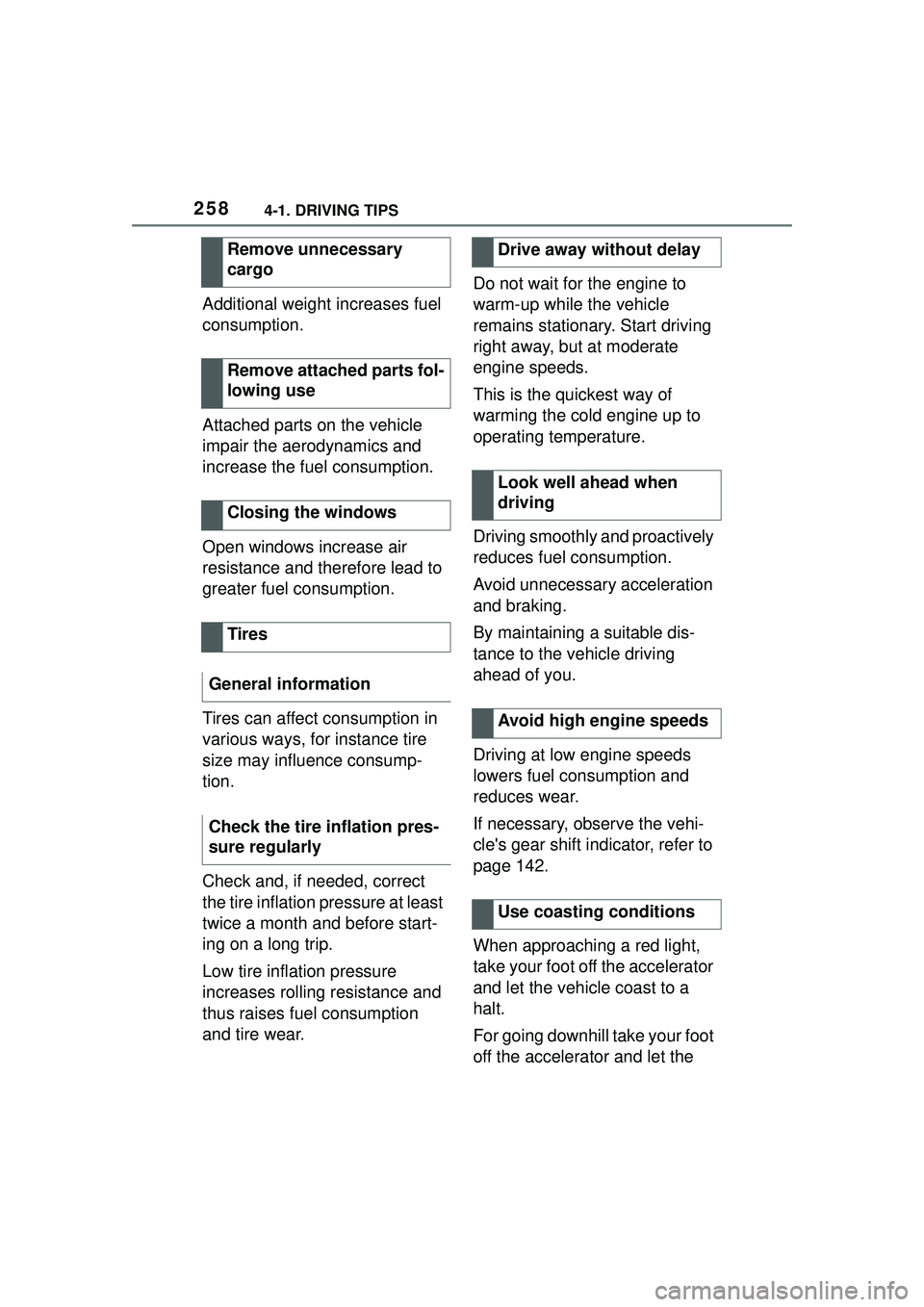
2584-1. DRIVING TIPS
Additional weight increases fuel
consumption.
Attached parts on the vehicle
impair the aerodynamics and
increase the fuel consumption.
Open windows increase air
resistance and therefore lead to
greater fuel consumption.
Tires can affect consumption in
various ways, for instance tire
size may influence consump-
tion.
Check and, if needed, correct
the tire inflation pressure at least
twice a month and before start-
ing on a long trip.
Low tire inflation pressure
increases rolling resistance and
thus raises fuel consumption
and tire wear.Do not wait for the engine to
warm-up while the vehicle
remains stationary. Start driving
right away, but at moderate
engine speeds.
This is the quickest way of
warming the cold engine up to
operating temperature.
Driving smoothly and proactively
reduces fuel consumption.
Avoid unnecessary acceleration
and braking.
By maintaining a suitable dis-
tance to the vehicle driving
ahead of you.
Driving at low engine speeds
lowers fuel consumption and
reduces wear.
If necessary, observe the vehi-
cle's gear shift indicator, refer to
page 142.
When approaching a red light,
take your foot off the accelerator
and let the vehicle coast to a
halt.
For going downhill take your foot
off the accelerator and let the
Remove unnecessary
cargo
Remove attached parts fol-
lowing use
Closing the windows
Tires
General information
Check the tire inflation pres-
sure regularly
Drive away without delay
Look well ahead when
driving
Avoid high engine speeds
Use coasting conditions
Page 264 of 356
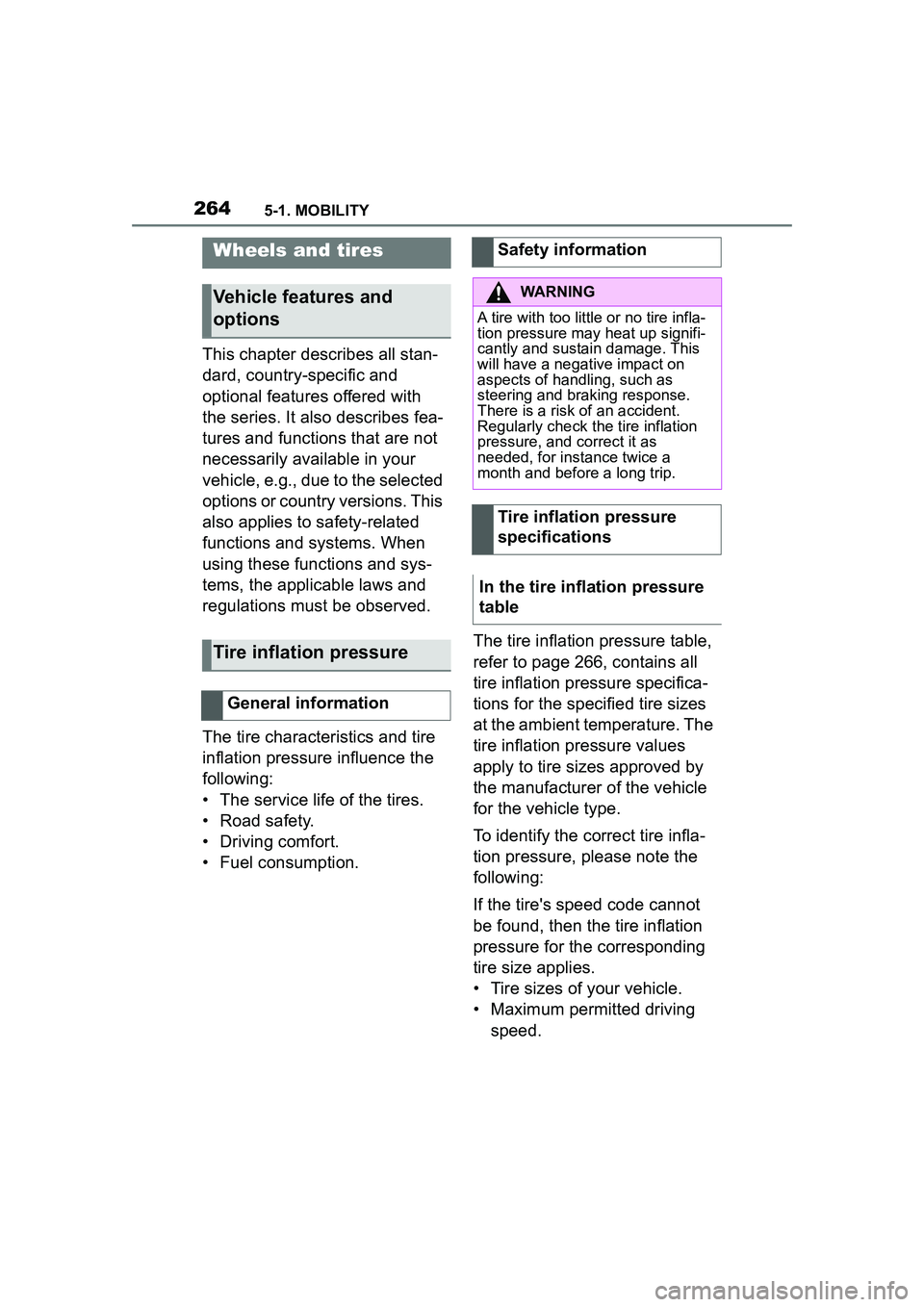
2645-1. MOBILITY
This chapter describes all stan-
dard, country-specific and
optional features offered with
the series. It also describes fea-
tures and functions that are not
necessarily available in your
vehicle, e.g., due to the selected
options or country versions. This
also applies to safety-related
functions and systems. When
using these functions and sys-
tems, the applicable laws and
regulations must be observed.
The tire characteristics and tire
inflation pressure influence the
following:
• The service life of the tires.
• Road safety.
• Driving comfort.
• Fuel consumption.The tire inflation pressure table,
refer to page 266, contains all
tire inflation pressure specifica-
tions for the specified tire sizes
at the ambient temperature. The
tire inflation pressure values
apply to tire sizes approved by
the manufacturer of the vehicle
for the vehicle type.
To identify the correct tire infla-
tion pressure, please note the
following:
If the tire's speed code cannot
be found, then the tire inflation
pressure for the corresponding
tire size applies.
• Tire sizes of your vehicle.
• Maximum permitted driving
speed.
Wheels and tires
Vehicle features and
options
Tire inflation pressure
General information
Safety information
WARNING
A tire with too little or no tire infla-
tion pressure may heat up signifi-
cantly and sustain damage. This
will have a negative impact on
aspects of handling, such as
steering and braking response.
There is a risk of an accident.
Regularly check the tire inflation
pressure, and correct it as
needed, for instance twice a
month and before a long trip.
Tire inflation pressure
specifications
In the tire inflation pressure
table
Page 288 of 356
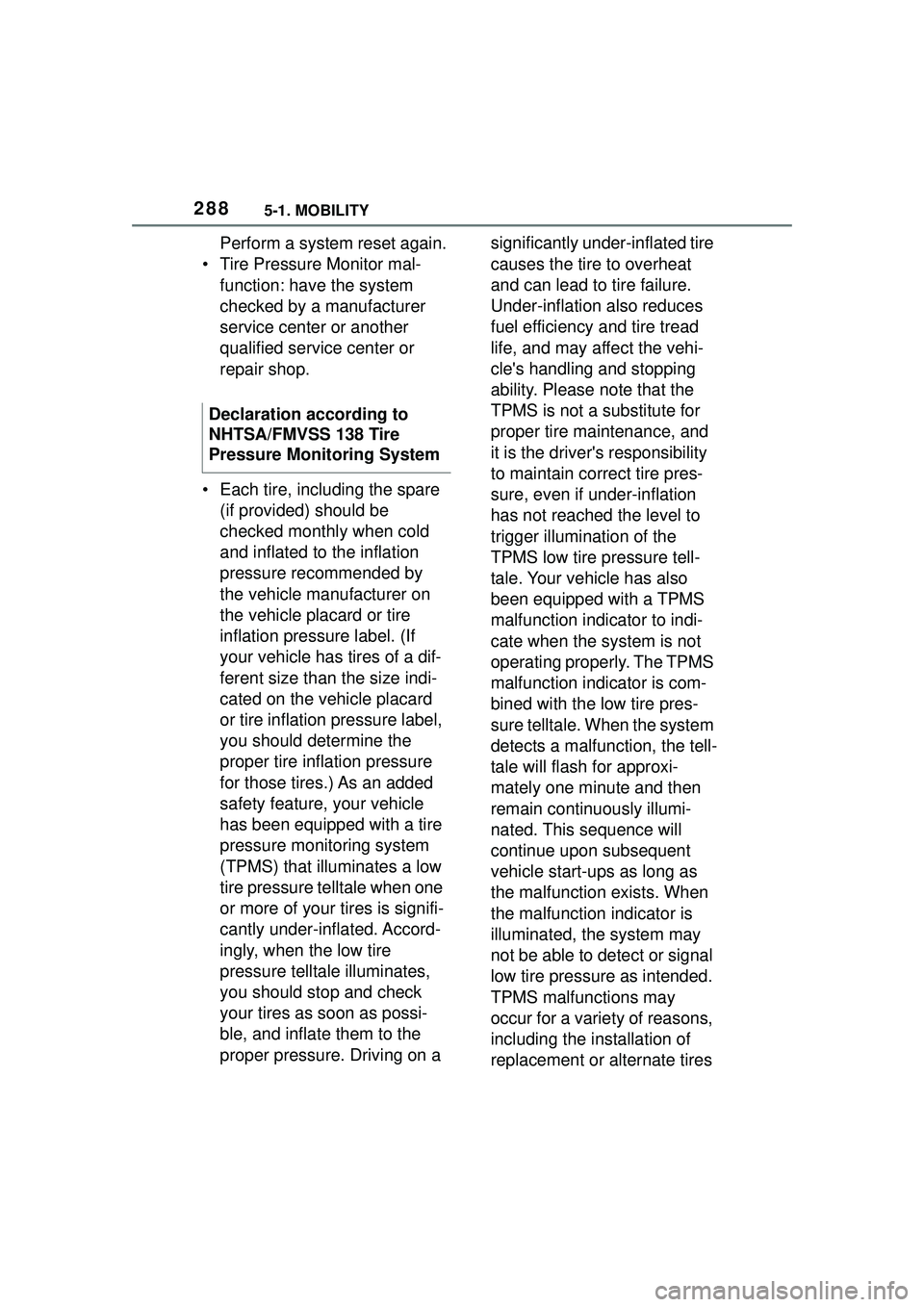
2885-1. MOBILITY
Perform a system reset again.
• Tire Pressure Monitor mal- function: have the system
checked by a manufacturer
service center or another
qualified service center or
repair shop.
• Each tire, including the spare (if provided) should be
checked monthly when cold
and inflated to the inflation
pressure recommended by
the vehicle manufacturer on
the vehicle placard or tire
inflation pressure label. (If
your vehicle has tires of a dif-
ferent size than the size indi-
cated on the vehicle placard
or tire inflation pressure label,
you should determine the
proper tire inflation pressure
for those tires.) As an added
safety feature, your vehicle
has been equipped with a tire
pressure monitoring system
(TPMS) that illuminates a low
tire pressure telltale when one
or more of your tires is signifi-
cantly under-inflated. Accord-
ingly, when the low tire
pressure telltale illuminates,
you should stop and check
your tires as soon as possi-
ble, and inflate them to the
proper pressure. Driving on a significantly under-inflated tire
causes the tire to overheat
and can lead to tire failure.
Under-inflation also reduces
fuel efficiency and tire tread
life, and may affect the vehi-
cle's handling and stopping
ability. Please note that the
TPMS is not a substitute for
proper tire maintenance, and
it is the driver's responsibility
to maintain correct tire pres-
sure, even if under-inflation
has not reached the level to
trigger illumination of the
TPMS low tire pressure tell-
tale. Your vehicle has also
been equipped with a TPMS
malfunction indicator to indi-
cate when the system is not
operating properly. The TPMS
malfunction indicator is com-
bined with the low tire pres-
sure telltale. When the system
detects a malfunction, the tell-
tale will flash for approxi-
mately one minute and then
remain continuously illumi-
nated. This sequence will
continue upon subsequent
vehicle start-ups as long as
the malfunction exists. When
the malfunction indicator is
illuminated, the system may
not be able to detect or signal
low tire pressure as intended.
TPMS malfunctions may
occur for a variety of reasons,
including the installation of
replacement or alternate tires
Declaration according to
NHTSA/FMVSS 138 Tire
Pressure Monitoring System
Page 348 of 356
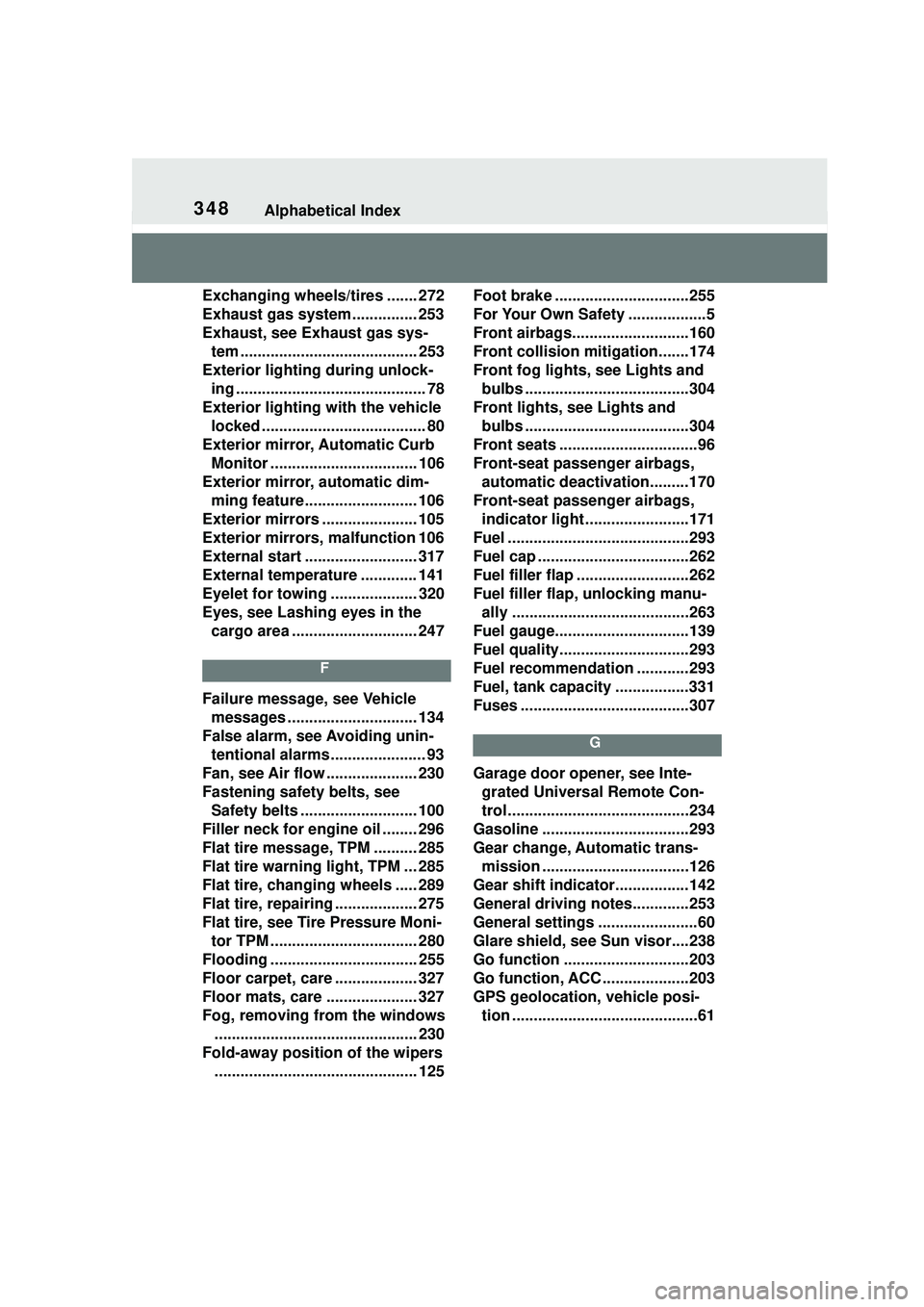
348Alphabetical Index
Exchanging wheels/tires ....... 272
Exhaust gas system ............... 253
Exhaust, see Exhaust gas sys-tem ......................................... 253
Exterior lighting during unlock- ing ............................................ 78
Exterior lighting with the vehicle
locked ...................................... 80
Exterior mirror, Automatic Curb Monitor .................................. 106
Exterior mirror, automatic dim- ming feature.......................... 106
Exterior mirrors ...................... 105
Exterior mirrors, malfunction 106
External start .......................... 317
External temperature ............. 141
Eyelet for towing .................... 320
Eyes, see Lashing eyes in the cargo area ............................. 247
F
Failure message, see Vehicle messages .............................. 134
False alarm, see Avoiding unin- tentional alarms...................... 93
Fan, see Air flow ..................... 230
Fastening safety belts, see Safety belts ........................... 100
Filler neck for engine oil ........ 296
Flat tire message, TPM .......... 285
Flat tire warning light, TPM ... 285
Flat tire, changing wheels ..... 289
Flat tire, repairing ................... 275
Flat tire, see Tire Pressure Moni- tor TPM .................................. 280
Flooding .................................. 255
Floor carpet, care ................... 327
Floor mats, care ..................... 327
Fog, removing from the windows ............................................... 230
Fold-away position of the wipers ............................................... 125 Foot brake ...............................255
For Your Own Safety ..................5
Front airbags...........................160
Front collision mitigation.......174
Front fog lights, see Lights and
bulbs ......................................304
Front lights, see Lights and bulbs ......................................304
Front seats ................................96
Front-seat passenger airbags, automatic deactivation.........170
Front-seat passenger airbags, indicator light ........................171
Fuel ..........................................293
Fuel cap ...................................262
Fuel filler flap ..........................262
Fuel filler flap, unlocking manu- ally .........................................263
Fuel gauge...............................139
Fuel quality..............................293
Fuel recommendation ............293
Fuel, tank capacity .................331
Fuses .......................................307
G
Garage door opener, see Inte- grated Universal Remote Con-
trol ..........................................234
Gasoline ..................................293
Gear change, Automatic trans- mission ..................................126
Gear shift indicator.................142
General driving notes.............253
General settings .......................60
Glare shield, see Sun visor....238
Go function .............................203
Go function, ACC ....................203
GPS geolocation, vehicle posi- tion ...........................................61
Page 352 of 356
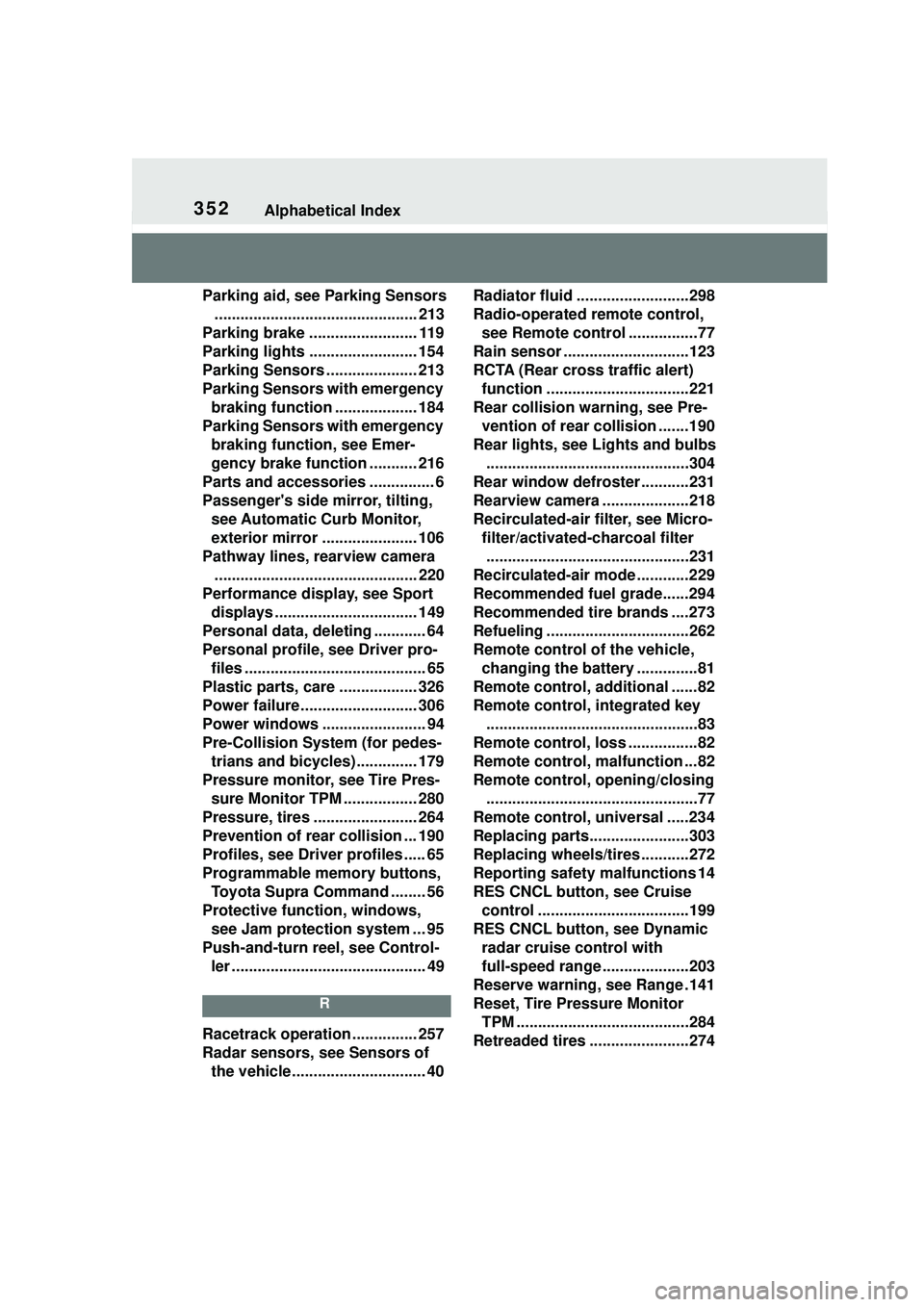
352Alphabetical Index
Parking aid, see Parking Sensors............................................... 213
Parking brake ......................... 119
Parking lights ......................... 154
Parking Sensors ..................... 213
Parking Sensors with emergency braking function ................... 184
Parking Sensors with emergency braking function, see Emer-
gency brake function ........... 216
Parts and accessories ............... 6
Passenger's side mirror, tilting, see Automatic Curb Monitor,
exterior mirror ...................... 106
Pathway lines, rearview camera ............................................... 220
Performance display, see Sport displays ................................. 149
Personal data, de leting ............ 64
Personal profile, see Driver pro- files .......................................... 65
Plastic parts, care .................. 326
Power failure ........................... 306
Power windows ........................ 94
Pre-Collision System (for pedes- trians and bicycles).............. 179
Pressure monitor, see Tire Pres- sure Monitor TPM ................. 280
Pressure, tires ........................ 264
Prevention of rear collision ... 190
Profiles, see Driver profiles ..... 65
Programmable memory buttons, Toyota Supra Command ........ 56
Protective function, windows, see Jam protection system ... 95
Push-and-turn reel, see Control- ler ............................................. 49
R
Racetrack operation ............... 257
Radar sensors, see Sensors of the vehicle............................... 40 Radiator fluid ..........................298
Radio-operated remote control,
see Remote cont rol ................77
Rain sensor .............................123
RCTA (Rear cross traffic alert) function .................................221
Rear collision warning, see Pre- vention of rear collision .......190
Rear lights, see Lights and bulbs ...............................................304
Rear window defroster ...........231
Rearview camera ....................218
Recirculated-air filter, see Micro- filter/activated-charcoal filter...............................................231
Recirculated-air mode ............229
Recommended fuel grade......294
Recommended tire brands ....273
Refueling ............ .....................262
Remote control of the vehicle, changing the battery ..............81
Remote control, additional ......82
Remote control, integrated key .................................................83
Remote control, loss ................82
Remote control, malfunction ...82
Remote control, opening/closing .................................................77
Remote control, universal .....234
Replacing parts.......................303
Replacing wheels/tires ...........272
Reporting safety malfunctions 14
RES CNCL button, see Cruise control ...................................199
RES CNCL button, see Dynamic radar cruise control with
full-speed range ....................203
Reserve warning, see Range .141
Reset, Tire Pressure Monitor TPM ........................................284
Retreaded tires .......................274